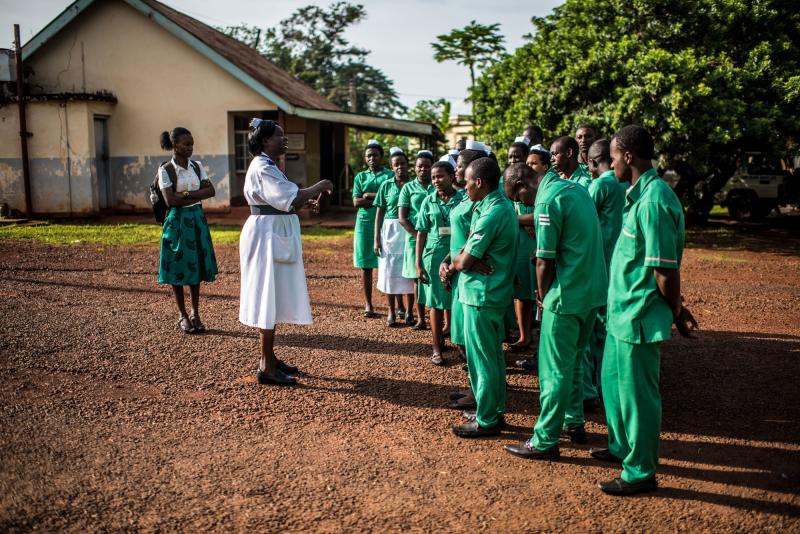Where We Work
See our interactive map


Nursing staff gather at the beginning of the day at the Jinja Regional Referral Hospital in Jinja, Uganda. IntraHealth's programs have helped increase funding for human resources for health in Uganda and add thousands of health workers to the workforce. Photo by Tommy Trenchard for IntraHealth International.
Here’s why the upcoming White House African Leaders Summit can help change that.
In June 2021, Dr. Lydia Kanyoro, a postgraduate student in pediatric medicine, committed suicide in her car outside the largest hospital in Kenya. She was one of so many medical staff who have suffered from depression and other related mental illnesses that may be attributed to tough working conditions and burnout, among other things, especially during this COVID pandemic.
When we support health workers, not only does their mental and physical health improve, but so do health systems and health services. We know that countries with adequate, trained, and capable health and care workforces have been more effective in responding to the pandemic and maintaining essential services, while those countries dealing with capacity constraints and other developmental challenges have fallen further behind, especially since COVID-19 has exacerbated the global health workforce shortage.
When we support health workers, their mental and physical health improve—and so do health services.
Right now, leaders from African countries and key African regional institutions are preparing to travel to Washington, DC, for the three-day US Africa Leaders Summit next week. Since health is on the agenda for day one, we must loudly call for these leaders to address all of the health workforce’s needs, including:
The health workforce shortage is becoming more and more concentrated in the Africa region. A WHO study from June, 2022, showcased how serious these shortages are, as well the insufficient capacity for workforce planning and health workforce information systems in the region. The United States, private-sector philanthropies, and others should partner with African governments to encourage the momentum that is clearly growing there to address the shortage and related challenges.
Here are three key areas that leaders gathering next week should focus on:
Health workforce planning is not a single activity—it is systemic. Systemic approaches are critical to building strong human resources systems, innovative approaches for learning and competency development, and a more productive workforce. So we must plan for different timelines (short, medium, long) and different levels (global, regional, health service pathway, specific cadre/career pathways and national).
And we must approach health workforce planning and management with data. Data, dialogue, decision, and dollar are the four Ds that are key for assessing human resources for health. Analyzing data, followed by discussions and subsequent decision-making by health leaders, can lead to financial resources to implement actions that support health workers.
Lastly, planning and management requires strong engagement with governments and their respective health workers, down to the grassroots level. In Kenya, we’ve seen a drastic difference in health workers’ attitudes and a reduction in strikes after we trained health management teams and trade union leaders on negotiation skills, labor dispute resolutions, and leadership, management, and governance skills.
It’s critical to skill, reskill, and upskill health workers through training and continuing education, including eLearning and other innovative approaches, to respond to disease trends and population needs. This includes training that focuses on:
We must see the role of health workers through their eyes to understand their needs, including for gender equality, women’s empowerment, and decent work.
Health workers often lack respect, recognition, fair compensation, and sufficient access to personal protective equipment. They also work in suboptimal working conditions where labor protection and rights are often neglected.
Female health workers also face unsafe working conditions, sexual harassment, gender-based pay gaps, and gender-based discrimination in the workplace. Anxiety, depression, and burnout is more frequent for female health workers, which is associated with increased domestic and family burdens, especially during the pandemic.
Health workers also face threats from instability and conflict. They and the health facilities they work in have been targeted in Central African Republic, Democratic Republic of the Congo, Nigeria, South Sudan, and many more countries. The Safeguarding Health in Conflict Coalition reported over 1,330 attacks on health facilities in 2021.
When President Biden and African heads of state meet next week at the US-Africa Leaders Summit, I urge them to consider health workers like Dr. Kanyoro and the stress that drove her to an untimely death. They should make concrete plans to strengthen health workers in the African region and address working conditions, going from rhetoric to decisive action.
These three approaches—planning and management, performance and productivity, and safety and well-being—along with funding and partnering effectively for the health workforce could change millions of lives. It could also save millions of lives that may be lost—like Dr. Kanyoro’s was—but we must act now.
Get the latest updates from the blog and eNews




